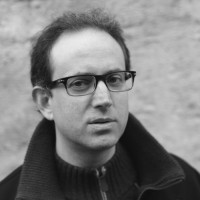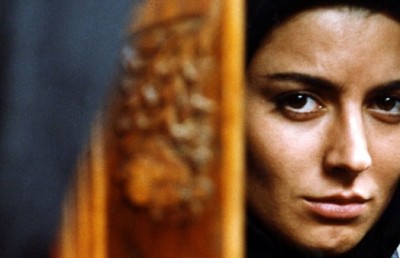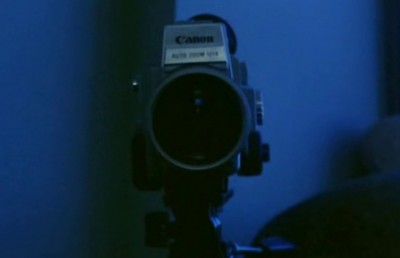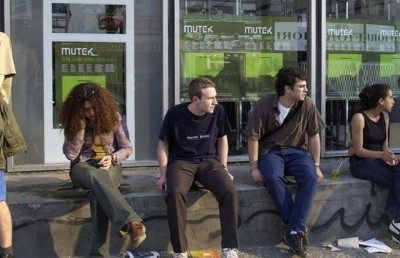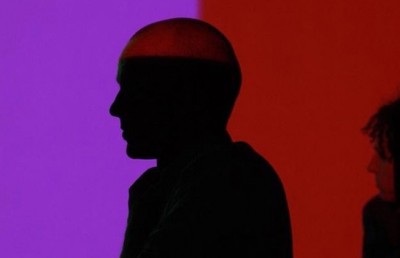Mutek 2002, Part 2
The Performances
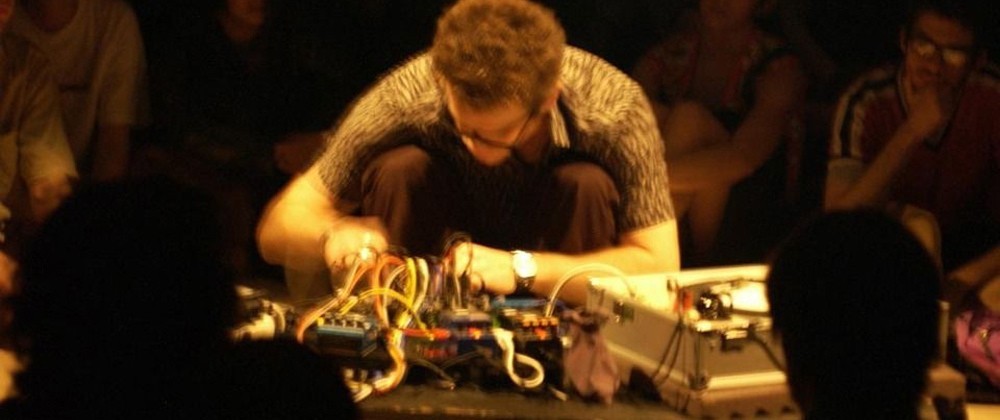
Mutek 2002 suggests that audiences might not yet be ready to accept live musical performance in the absence of a performer (see Part One of this report for a detailed discussion of issues surrounding the idea of performance in the age of the PowerBook musician). The shows at Metropolis, one of Montreal’s more popular stand-up concert venues, were geared towards the industry standard for the presentation of stars, complete with flashy lights and a hell of a lot of fog. Indeed, when Luomo (a.k.a. Vladislav Delay) played on Saturday night, I actually felt like I was in the presence of a living music-maker. Towards the end of the set he was backlit in a sea of white and his bobbing silhouette cut through the fog like the shadow of night giving way to a Scandinavian morning. I felt his presence as a dance music superstar, and even boogied just a little bit. Though I prefer the more structural and minimalist approach he adopts under his own name, I found the Luomo project to be an interesting hint at his glitchy offbeat side mixed with sullen and icy female vocals over warm yet edgy basslines.
Delay’s performance with Antye Grie-Fuchs (a.k.a. AGF) earlier that day at the Société des Arts Technologiques (SAT) allowed him a little more room to experiment, and the two of them provided another keen sense of human presence on stage. AGF began with a solo set, whispering her own brand of vocalizations (i.e. reading computer code interspersed with romantic verse) into her microphone and manipulating them in real-time on her laptop. Through this process she creates a stuttering and fragmented parchment of powerful lyric to fill in her melancholic ambient soundscapes peppered with startlingly chopped up outbursts of rhythm. Her approach to the fragmentation of her own voice reminds me of some of John Oswald’s intense reorganizations of pop vocals, notably the more ethereal moments in his dramatic fractalization of Michael Jackson’s “Bad”(1). AGF herself sees the value in providing a voice to her sample manipulations in a live setting:
For me, it’s always been easy to be onstage only with a laptop, because I’m using my voice all the time, which people immediately find attractive and personal. It’s super-intimate somehow. That’s why it’s cool for us – there are the many possibilities that you have when you use a laptop, and yet I still have the ability to look into peoples’ eyes and sing, which is quite cool (2).
AGF undoubtedly evokes regular comparisons with Bjork, who is also known for joining her distinctive vocals and compositional style with the wonders of laptop technology. Bjork’s recent album Vespertine features some electronic collaboration with San Francisco duo Matmos who appeared at Mutek 2001. Though their styles are actually quite different, both AFG and Bjork have a deep appreciation for the subtlety and human touch that can be achieved via the laptop computer. In speaking about her laptop experiences, Bjork has this to say: “It’s all a secret. There’s no oxygen in that world. It operates like your mind. Your thought process is very similar…I use micro-beats, a lot of whispery vocals, which I think sound amazing when they’re downloaded because of the secrecy of the medium” (3).
Bjork and AGF also share an appreciation for the intimacy that can be achieved through the exploration of fragmentation in their work. David Toop ponders Bjork’s uniqueness with the question “How do you compose songs, particularly love songs, that are genuinely new, and affecting, without reprising all the structural tricks that now seem so worn out?” Interestingly, he turns to Wong Kar Wai’s In the Mood for Love as a model for how a structure can be “beguilingly fragmented and allusive, yet whose emotional tenor remains compelling, deeply touching, overwhelmingly romantic” (4).
Both Bjork and AGF seek out new structures through exploration of the allusively minute details in both vocal and instrumental sample manipulations, and both do justice to Toop’s comparison with Wong Kar Wai’s undisputed masterpiece of audio/visual synthesis. In her duet with Vladislav Delay, AGF’s brand of sample manipulations worked magic with her counterpart’s off-time beat signatures and his own interest in the dark side of ambient. And the two of them couldn’t have looked happier. I really got the sense (both onstage and the next day when I spied them arms over each other’s shoulders on the Atom dance floor) that this was a meeting of creative souls who were bonded with one another in spirit. Cheesy eh? It was nice to see.
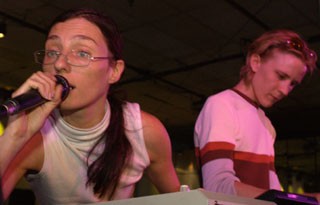
AGF and Vladislav Delay
Mathew Herbert (a.k.a. Radio Boy) also had something to say about the lack of visible performance in computer-based music. He was in fine form during Panel 4, despite his lack of voice due to illness. He made it very clear that he felt a lot of the music world has sold out, singling out Sting and Moby as particularly “disgusting” examples for their endorsement of big corporate product. He recounted his own experience watching his name, projected on giant screens around hip clubs, dissolve into cell-phone commercials while he performed. He also mentioned that he recently had to make a very tough decision upon being offered a considerable sum of money for his music to be used commercially – he never did say if he took it or not. Based on his Radio Boy act, I would have to assume not. His answer to musicians selling out to the big companies is to make music by destroying corporate product onstage, sampling the sounds of the destruction in real time, then spitting it back out in deformed and always interesting ways. This is a strategy that makes for a very entertaining show to watch.
Among his victims were Starbucks coffee cups, Gap underwear, and Big Macs which he scrunched, squeezed, stretched, and tore to pieces in front of his quadruple microphone array, yielding textures and beats that really got the crowd moving. Good thing the show was at Metropolis and not Place Des Arts, the latter being Montreal’s version of the Royal Festival Hall (see Part One for more details).
There were a large number of acts that compensated for the lack of human visibility by making the performer’s computer screens visible to the audience, an interesting way of making visible the micro-performances of wrists and fingers that Cascone referred to in the first part of this report. At the SAT venue in particular, there were numerous screens onto which were projected the interfaces that the performers were using. It was interesting to see the various kinds of software in operation. In the case of Zack Settel, we could watch a visual representation of his sound steering through quadrophonic space – kinda neat. Alexandre Burton’s Max/MSP manipulations were also interesting to watch; the graphics illustrate, in a family-tree format, the connections he was building between the various elements used. And it was especially fun to see the crash message come up when Burton’s PowerBook failed, to which he responded by throwing up his hands. We all chuckled, and a CD promptly took over such that many of us weren’t sure that the performance had actually stopped.
On the retro side of things, Atom (a.k.a. Uwe Schmidt) used only a sampler for his performance on Mutek’s final evening at the SAT. The display on the sampler was projected onscreen, and must have satisfied anyone longing to return to the aesthetics of DOS readouts and Dot Matrix printing. The sampler is a very organized and linear machine to use as a performance tool, demanding a decidedly un-postmodern method of understanding what your show is going to be before you send it out to the world. The contemporary laptop allows for a much broader range of real-time decision making and yes, even improvisation. The sampler, on the other hand, requires that all your samples be loaded up in the order you want to lay them down, effectively restricting the performer to a pre-set strategy for musical progression. The interface display reflects this quality, and must be a nightmare to negotiate in the heat of a live presentation.
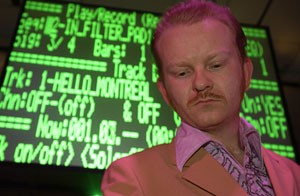
Atom
The visualization of the music creation process is one of the main changes that computers have brought to the world of sound. The desire to unify sound and image, however, is much older. Calling attention to the process of creation also has a long tradition, particularly in the realm of avant-garde cinema. Many computer-based musicians are trying to add a visual element to their work beyond showing us their raw process and the synthesis of sound and image is becoming ever more popular as video and sound production are increasingly joined within the same computer paradigms. Tetsu Inoue’s Waterloo Terminal provides an interesting example of sound/image relationships. In his compositional process, Inoue fed images he had taken of the London railway terminal into his computer, and translated the architectural patterns into sound through various mathematical processes. This is a bit esoteric, but it demonstrates a true belief in the oneness that sound and image can be, not to mention being a unique approach to the exploration of sound in space as well.
On another front, the art of live video editing will be exploding soon enough, as more and more acts seek to present an increasingly holistic vision of their artistic expression. In Montreal we see more of this kind of thing during FCMM, and Alain Mongeau has expressed his explicit desire for Mutek to be a sonic equivalent to the emphasis on digital visuals that FCMM presents each year (5). However, as we have seen, visual elements to sonic performance abound at Mutek.
One of the most notable examples of live video manipulations came from Sue and the Musorkians (a.k.a. Sue Costible). Orthlong Musork, the label she co-owns, had its showcase on Saturday afternoon at the SAT featuring Stephan Mathieu, Timeblind, AGF, and Vladislav Delay. For the first two sets, Sue presented an interesting blend of optical and digital manipulations. To accompany Stephan Mathieu she had on screen a simple textured pattern resembling an upholstery weave that shifted colours from top to bottom on a line by line basis. The slow movement downward of the colour progression reminded me of many things, especially the visual representation of a PC’s disk de-fragmentation operation, slowly shifting itself line by line from top to bottom. This is also reminiscent of the refreshing of a video display; CRT-based television and computer displays paint their images in very fast moving downward sweeps one line at a time.
Upon closer inspection, Sue’s upholstery weave texture revealed that it alternated colours between each weave, much like a purple sofa can, on closer inspection, be seen to be a weave of red and blue thread. Sue’s shifting colour was achieved by altering the colour of the alternating strands of “thread” that made up the image. The thread weave concept also calls attention to the idea of the pixel as being the standard unit of visual imagery. The little diamonds of space created by the criss-crossing pattern of the weave essentially made up the pixel structure of the texture, and each diamond changed colour individually along the horizontal axis from top to bottom. The idea of the intersection of two different colours of thread creating a third colour reflects some of the music at issue here, wherein so much is based on the juxtaposition of isolated sampled materials. The purple sofa created out of the red and blue weave is like the layering of distinct sounds to give an impression of something more than just the sum of the two parts.
Stephen Mathieu’s music here was in the vein of the sustained soundscape, exploring the gradual shift of a single texture with nuances that become apparent over time. This is, of course, also a relevant sonic counterpart to Sue’s visual tapestry. Mathieu also played a set on Thursday night at Ex-Centris entitled Sad Mac Studies. His Ex-Centris show differed in that it was more melodic, though also based on the idea of a sustained sonic texture slowly shifting over time. Whereas on Saturday the frequencies were low and the texture more that of the white noise heard between the stations on a radio dial, his Sad Mac Studies were higher frequency and more coherent organic sounds playing melancholic yet somehow hopeful melodic strains in varying patterns of repetition and alternation.
Philip Sherburne has this to say about Mathieu’s style: “The German artist deftly manipulates software-based composition and editing tools to draw out hidden strands of sound from recordings and acoustic instruments alike, so that deceptively simple loops and fragments, framed and processed almost haphazardly, yield striking crystallizations”(6). Sad Mac Studies ended with a section of such crystallization forged from samples of a Fender Rhodes electric piano. This has always been one of my favorite instruments, both to listen to and to play. To touch the spongy weight of its keys is like melting into the piano itself, and the warmth of its tone matches its unparalleled tactility. Mathieu’s treatment of the unique Rhodes sound was to alter the attack and decay of the individual notes by starting them late or ending them early. This approach reminds me of the volume swell that I always enjoyed practicing; a key is depressed with the volume level all the way down, and then pumped up as the note decays. This technique is popular in the electric guitar world as well (perfected by Roy Buchanan in the early 1970’s). Mathieu’s alteration of the attack is more abrupt, cutting into the note after the initial attack but without the grace of the volume swell to create smoothness. The result is more like the effect of a skipping CD, jumping over notes that seem like they should be in tact. The effect is one I like very much, and illustrates a keen sense of the interaction between sampling technology and the source of the sample. In Mathieu’s own words: “I want to have the spirit of the source I’m processing in the music I’m creating” (7).
In the same set on Thursday evening at Ex-Centris, Leon Lo (a.k.a. Helen of Troy) and Janek Schaefer also presented some interesting takes on the relationship between acoustic and electronic sound, as well as addressing the issue of performance vs. reproduction. Helen of Troy utilized a violin, mixer, delay pedals and feedback to create a dense and beautiful layering of sounds. Playing his violin, he would loop and delay portions of his strokes in real-time, then play some more over top and repeat the process. The interaction between the live and captured violin playing elucidated all manner of harmonic relationships between sustained tones, and weaved a wonderful basket of lush string ambience through the quietly seated audience.
Helen of Troy’s form of playing with and against one’s self reminds me of John Oswald’s Spectre as performed by the Kronos String Quartet. Designed to call attention to the relationships between reproduction technology and the idea of live performance, Oswald’s piece had Kronos begin by bowing out a simple one note drone while the sound was captured and played back over top. Gradually, as the layers built up, the quartet raised their bows higher and higher off the strings until they were simply bowing in air. Yet the sound carried on (8). David Lynch gives a similar demonstration of performance in the age of reproduction in the Théatro Silencio sequence of Mulholland Drive (2001).
Janek Schaefer also provided a nice set that evening. He sat on the floor amidst the crowd in the middle of the room where he had his rig set up. His textures were shaped around the emanations of the two-armed turntable on which he played his own self-cut vinyl. Schaefer takes a page or two from Mutek veteran Thomas Brinkmann. Brinkmann’s exploration into creating rhythms from self-scratched vinyl was presented in the first twenty minutes of his 2001 Mutek appearance and is well-documented on releases such as Klick and Totes Rennen. His adventures into two-armed turntable land are also noteworthy, having taken the minimalist electronica stylings of Mike Ink and Plastikman and subjecting them to the delay effect created by two tone-arms playing the same disc (as heard on Studio 1 Variationen and Concept 1 VR respectively).
Schaefer’s aesthetic ends are drastically different from those of Brinkmann, however. The immediate effect of his double-armed table was not readily discernible, as the source material is unrecognizable. His approach is more subtle. Creating locked grooves out of vinyl noise by placing a smaller disc on top of the 12” (thus preventing the stylus from progressing along the groove as it sits in place, caught by the rim of the smaller disc), he then subjected this loop to various manipulations through his mixing board and a host of pedals. The result was far less jarring than Martin Tétrault’s multi-armed noise box which he dexterously attacked over the ambient soundscapes of I8U at last year’s fest. With regards to Schaefer, the Mutek guide invited us to “experience an evolving dense stream of macrosonic textures, pulses and frequencies that conjure up images of an architectonic landscape passing through Ballard’s Drowned World” (9). Well, it was something like that. I enjoyed it for sure. Mathieu, Schaefer, and Helen of Troy made Thursday night at Ex-Centris a special evening indeed.
Back to Sue and the Musorkians on Saturday afternoon. Following Stephan Mathieu came Chris Sattinger under the name Timeblind. For this set, Sue shifted visual aesthetics drastically. She had what amounted to a digital overhead projector: a standard light table was the base, with a digital video camera mounted above it, patched through her laptop and projected onto the many screens around the venue. Her assault on the light table was very much akin to the dexterous manipulations practiced by scratch turntablists. Her arsenal, instead of vinyl, consisted of slides, Viewmaster discs, filmstrips, and various translucent pieces of paper and acetate with a variety of markings and colours.
Over the course of the set she created an endlessly shifting canvas of superimpositions that explored the juxtaposition, and often simultaneity, of stillness and motion. To begin with, the camera was mounted on a less than stable rod that quivered gently along with the whole table. This slight motion was amplified by the digitization of the image through the computer, creating the characteristic jerkiness on sudden movements that is a regular occurrence in digital motion capturing. This combination created a sense of constant movement to the images Sue laid down, which was then added to by the constant shuffling and rearranging of the various materials.
She started off with some simple layering of the acetates and translucent papers, slightly moving them around to create shifting lines between where the various layers would intersect. As the set went on, she started laying down a variety of slides and mixing them all around. Through the digitization process, with its slight delay and stuttered motion, the effect was not unlike what we see when a PC is in the process of crashing, when trying to move a window results in endless duplicates creating a whole series of windows streaked across the screen. The content of the slides added some of the visual texture, of course, but the borders of the slides as they lay all over each other while being shuffled around created the main imagery.
All the while, no attempt was made to keep her fingers from showing up on the screen while she manipulated the materials, thus incorporating her process into the aesthetic of the work as so many of the Mutek musicians do. When it came time for the filmstrips, she began to emulate the motion of a projector. Manually running the film across the light table so that there was a semblance of motion, this motion combined with the fact that many frames of the strip were visible at any given moment. I found this to be an interesting approach to confronting the basic functioning of film, showing us the individual components (frames) while also the sense of motion they can achieve. The delay and stuttering effect inherent in the digitization also created a visible analogy to the eye’s own process of persistence of vision, where the retina retains a single image for an instant after the image has passed. This, in conjunction with what perception theorists call the “phi-phenomenom”, is what makes the perception of motion at 24 frames per second possible, and Sue’s contraption called attention to this persistence in more ways than one.
On the whole I found Sue’s visual treatments to be the most interesting visual counterpart to any of the music at the festival. Her combination of the foregrounding of process, her interest in the materiality of her medium, and the constantly shifting textures that resulted were a welcome addition to the showcase of a label that features artists exploring the sonic equivalent of Sue’s visual interests.
However, the search for a true synthesis between sound and image in this festival (or any other) is far from being over. The age of the Video Jockey is drawing nearer and nearer, where the sonic practices of the live manipulator of recorded sound can be applied to visuals with equal effect. The dream of Disney’s Fantasia and Michel Chion’s “transsensoriality” (the sonic qualities of vision and vice versa) (10) alike is coming closer and closer to realization as audio/visual artists plumb the outer reaches of sound/image relationships through new technologies.
There was only one act that I saw at this year’s Mutek which presented an attempt at true sound/image connection. On Mutek’s opening night at Ex-Centris, Montreal duo Dioxyde (Herman Weeb and Dominique [T] Skoltz) presented Ovskii: Acoustic Pigments in Real Time. The Mutek guide suggests that “their multi-cellular work experimentally investigates the confrontation and tension between carbon and silicon based cultures” (11). My experience has been that most of the music Mutek is concerned with can be described this way, but that doesn’t take away from the relevance of such exploration in the case of Dioxyde.
Using their newly developed LoeeFrek digital instrument, allowing the conversion of real-time sound into digital imagery, Dioxyde’s Ovskii provided an interesting audio/visual aesthetic. Their sonic textures might best be described as granular, exploring the feel of digital white noise and crackling static charges in varying degrees, relishing the interplay between the apparent continuous nature of the sound vs. its tiny component grains. The visuals took on this aesthetic as well. White grains on a black background, the morphing dunes resembled very much the shifting sand animations from Sesame Street (remember? The ones with the Eastern Canadian hillbilly fiddle music?). Starting out in a straight horizontal line, the grains would move about and warp into various forms in direct connection with the sound, creating patterns akin to what one might see drawn with a raw laser at a planetarium light show or the awkward scribblings of a Mr. Doodle board. I appreciated the basic idea of Dioxyde’s performance, but it could go a lot farther, and is ultimately just another indication of how young the world of live A/V performance actually is.
In the realm of recorded media, sound/image relationships have been explored to a much greater extent since long before digital technologies became a reality. Experimental film pioneers like Norman McLaren and the Whitney brothers have been getting down to the nuances of the common material nature of both sound and image for some time. For McLaren, the scratch has been one of the fundamental tools to explore audio/visual intersections on film. The idea that you can create both sound and image by scratching the celluloid is crucial to so much of the current interest in the textures of imperfection. John Whitney takes a more mathematical approach and is particularly noteworthy for his work with early computer technology in the late 70s and 80s (12). Whitney’s interest in the idea that harmonic and melodic equations can be translated into both sound and image, and his work in creating computer programs to carry out these translations, has been absolutely essential (if often overlooked) to the environment of experimentation that makes festivals like Mutek and FCMM possible. Both McLaren and Whitney seek the unified source at the heart of these two human senses, and they do so by getting down to the microstructure underlying both.
The idea of the imperfection of technology and its aesthetic qualities is, of course, at the heart of so much of Mutek’s music. Contemporary interest in exploiting technological imperfection for musical purposes took flight with the scratching of records by hip-hop turntableists. Over the years, with each new technology, new varieties of the same thing have arisen. Marcus Popp (a.k.a. Oval) uses the sound of CD skipping as the textural and rhythmic base for much of his music. Pole took the sound of his malfunctioning sound machine and turned it into a veritable phenomenon. With all the myriad different softwares that abound these days along with their unique glitches, the sounds of imperfection are everywhere.
This interest in the imperfections, microstructure, and nuances of electronic machinery makes sense to me. We are imperfect beings, we create imperfect technology, and we relate to the imperfections we see in the world and in our creations. Friederich Kittler relates the story of Thomas Edison hollering into the bell of his phonographic cylinder recorder, not only because he had no amplification device but also because he was half-deaf himself. Edison created a technology that would go on to compensate for defects like his own while yielding a whole new world of imperfections at the same time. Thus, as Kittler notes, “a physical impairment was at the beginning of mechanical sound recording” (13), and the remnants of this impairment have gone on to be the shining star of contemporary computer-based music.
During Panel 4 we were treated to some video excerpts of a recent tirade by Touch label owner Jon Wozencroft. Speaking at the Arts Electronica awards on behalf of this year’s big winner Ryoji Ikeda (who was too shy to get up and make a speech), Wozencroft delivered a shit-stirring soliloquy presenting his take on the current state of computer-based music. Drawing on Kim Cascone’s recent reference to glitch-based music as being based on “the aesthetics of failure” (14), Wozencroft suggests that there is far too much emphasis on such failure these days. Using the recent appearance of a three disc volume of Clicks n’ Cuts as an example, he poses the question “when is enough enough?” He considers the emphasis on failure to be “a dialog with the destroyer” instead of a creative process. He uses the concept of the aesthetics of failure as an analogy for his belief that the music world is not moving forward when it gets bogged down in the mire of less than perfect technological by-products. His real point, however, is that the clicks, cuts, glitch-beats etc. have been done to death, and it is time to move on.
It is my feeling, however, that his analogy of failure does not do justice to the worlds that have been opened up through technological imperfection, and certainly does not acknowledge how much we have learned about ourselves through the exploration of our machines. The concept of failure is just that: a concept. We can change what we understand failure to be; success is very often nothing more than a rearrangement of our belief systems. The sound of a CD skipping is only a failure with respect to the intended design of the machine. However, so much contemporary music seeks to celebrate these failures by saying that they are not failures at all, but rather new ways of understanding the technology and its inherent aesthetics. I agree that we don’t need any more house beats disguised as experimental music by the insertion of digital glitches here and there. But the navigation through the micro world of our selves and our systems is only just beginning, and I believe that the further in we go, the farther out we will travel. This is the essence of the relationship between micro and macro structures that I find so fascinating, and which has been the subject of so much art through all the ages. When we humans postulate our place in the universe, we are posing the question of how we relate to the bigger picture. When we zoom in on the nuances of daily life, we understand the grand design a little better.
As put so succinctly in Jim Jarmusch’s Ghost Dog: The Way of the Samurai: “Matters of great concern should be treated lightly….Matters of small concern should be treated seriously.” We can never comprehend the totality of the universe by trying to take in the vastness of everything at once. But great attention paid to a tiny glitch, one that could easily go unnoticed, can yield startling insights. Another bit of insight from Ghost Dog might well be evoked here: “It is said that what is called ‘the spirit of an age’ is something to which one cannot return….Thus it is important to make the best out of every generation.” We are now in the age of digital awakening, working out all the nuances of the new technologies that will go on to form the world of the future. It may well be that all we remember of these fledgling technologies is their quirks, and I suggest we do not ignore these quirks for fear that the spirit of this age may be forever forgotten once our current tools are long gone.
Mutek 2002, Part 1: Panels and Critical Discourse
Notes:
1 – John Oswald’s “DAB” can be heard on the recent compilation Plunderphonics 69/96, available from www.negativland.com.
2 – AGF quoted by Susanna Bolle. “Shared Interest.” XLR8R. No. 58. April 2002: 38.
3 – Bjork quoted by David Toop. “Alone in the Dark.” The Wire. No. 211. Sept. 2001: 37.
4 – Toop, David. Ibid.
5 – Alain Mongeau quoted by Walid Hijazi. “L’art du bruit.” Night Life Magazine. May 2002: 25.
6 – Sherburne, Philip. “Stepahn Mathieu: Phantoms of Liberty.” The Wire. No. 211. Sept. 2001: 16.
7 – Stephan Mathieu quoted by Philip Surburne in Ibid.
8 – Keenan, David. “Undoing Time.” The Wire. No. 219. May 2002: 46.
9 – Mutek festival guide 2002: 15.
10 – Chion, Michel. Audiovision: Sound on Screen. Claudia Gorbman, trans. New York: Columbia UP 1994:137.
11 – Mutek festival guide 2002: 7.
12 – Whitney, John H. Digital Harmony: On the Complementarity of Music and Visual Art. Peterborough, New Hampshire: McGraw-Hill, 1980.
13 – Kittler, Friederich A. Gramophone, Film, Typewriter. Geoffrey Winthrop-Young and Michael Wutz, trans. Stanford: Stanford University Press, 1999: 22
14 – Cascone, Kim. “The Aesthetics of Failure: ‘Post-Digital’ Tendencies in Contemporary Computer Music.” Computer Music Journal. Vol. 24

